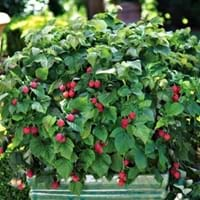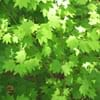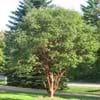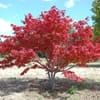Life Span
Perennial
Perennial
Origin
Australia
Not Available
Types
Not Available
not available
Habitat
Scrubs, tussock grasslands, Upland savannas
disturbed sites, Forest edges, old gardens, Riverbanks, Roadsides
USDA Hardiness Zone
10-11
4-9
Sunset Zone
8, 9, 12, 13, 14, 15, 16, 17, 18, 19, 20, 21, 22, 23, 24
A1, A2, A3, 1a, 1b, 2a, 2b, 3a, 3b, 4, 5, 6, 7, 8, 9, 10, 11, 12, 13, 14, 15, 16, 17, 18, 19, 20, 21, 22, 23, 24
Habit
Upright/Erect
Upright/Erect
Flower Color
Lemon yellow
White
Flower Color Modifier
Bicolor
Bicolor
Fruit Color
Gray Green
Red
Leaf Color in Spring
Blue Green
Green
Leaf Color in Summer
Blue Green
Green
Leaf Color in Fall
Blue Green
Green
Leaf Color in Winter
Blue Green
Light Green
Leaf Shape
Long Narrow
Spade shaped
Plant Season
Spring
Spring, Summer, Fall
Sunlight
Full Sun
Full Sun, Partial Sun
Type of Soil
Loam, Sand
Loam, Sand
The pH of Soil
Acidic, Neutral, Alkaline
Acidic, Neutral
Soil Drainage
Well drained
Well drained
Bloom Time
Spring, Late Winter
Spring, Summer
Tolerances
Drought
Drought
Where to Plant?
Ground
Container, Ground, Pot
How to Plant?
Seedlings
Seedlings, Stem Planting, Transplanting
Plant Maintenance
Medium
Medium
Watering Requirements
Do not water excessively
Do Not over Water, Keep ground moist
In Summer
Lots of watering
Lots of watering
In Spring
Moderate
Moderate
In Winter
Average Water
Average Water
Soil pH
Acidic, Neutral, Alkaline
Acidic, Neutral
Soil Type
Loam, Sand
Loam, Sand
Soil Drainage Capacity
Well drained
Well drained
Sun Exposure
Full Sun
Full Sun, Partial Sun
Pruning
Remove dead or diseased plant parts, Requires little pruning
Remove damaged leaves, Remove dead branches, Remove dead leaves
Fertilizers
All-Purpose Liquid Fertilizer, No fertilizers needed
All-Purpose Liquid Fertilizer
Pests and Diseases
Insects, Root rot
Red blotch
Plant Tolerance
Drought
Drought
Flowers
Showy
Insignificant
Flower Petal Number
Single
Single
Foliage Texture
Fine
Medium
Foliage Sheen
Matte
Matte
Attracts
Butterflies
Butterflies
Allergy
Asthma, Eye irritation, Headache, Nose Irritation, Throat itching, Vomiting
Skin rash
Aesthetic Uses
Showy Purposes
Showy Purposes
Beauty Benefits
Not Available
Good for skin
Environmental Uses
Air purification, soil stabilisation
Not Available
Medicinal Uses
Not Available
Sore throat, Ulcers, Wounds
Part of Plant Used
Flowers, Sap, Seeds
Fruits
Other Uses
Used as a dye, Wood is used fore making tools
Edible syrup, Used As Food, Used as Ornamental plant
Used As Indoor Plant
No
No
Used As Outdoor Plant
Yes
Yes
Garden Design
Shade Trees, Street Trees
Edible, Fruit / Fruit Tree, Hedges
Botanical Name
ACACIA aneura
RUBUS 'Amity'
Common Name
Mulga, True Mulga
Amity Raspberry, Raspberry
In French
Mulga
Framboise
In Spanish
Mulga
Frambuesa
In Portuguese
Mulga
Framboesa
In Latin
Mulga
RUBUS IDAEUS
Phylum
Magnoliophyta
Anthophyta
Class
Magnoliopsida
Eudicotyledones
Clade
Angiosperms, Eudicots, Rosids
Not Available
Tribe
Not Available
Not Available
Subfamily
Not Available
Not Available
Number of Species
Not Available
Importance of Mulga Tree and Raspberry
Want to have the most appropriate plant for your garden? You might want to know the importance of Mulga Tree and Raspberry. Basically, these two plants vary in many aspects. Compare Mulga Tree and Raspberry as they differ in many characteristics such as their life, care, benefits, facts, etc. Every gardener must at least have the slightest clue about the plants he wants to plant in his garden. Compare their benefits, which differ in many ways like facts and uses. The medicinal use of Mulga Tree is Not Available whereas of Raspberry is Sore throat, Ulcers and Wounds. Mulga Tree has beauty benefits as follows: Not Available while Raspberry has beauty benefits as follows: Not Available.
Compare Facts of Mulga Tree vs Raspberry
How to choose the best garden plant for your garden depending upon its facts? Here garden plant comparison will help you to solve this query. Compare the facts of Mulga Tree vs Raspberry and know which one to choose. As garden plants have benefits and other uses, allergy is also a major drawback of plants for some people. Allergic reactions of Mulga Tree are Asthma, Eye irritation, Headache, Nose Irritation, Throat itching and Vomiting whereas of Raspberry have Skin rash respectively. Having a fruit bearing plant in your garden can be a plus point of your garden. Mulga Tree has no showy fruits and Raspberry has showy fruits. Also Mulga Tree is not flowering and Raspberry is not flowering . You can compare Mulga Tree and Raspberry facts and facts of other plants too.





